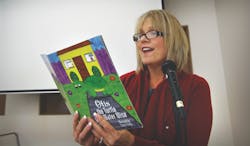Standing in front of a room of wide-eyed students, Malea Ortloff uses turtles and dragons to teach water conservation. For many of the students, the tales told by Otis the Turtle, Savvy the Water Drop and Dewie the Dragon are stories they can relate to in their own lives.
Through its annual publication of children’s books and corresponding grade-appropriate classroom education curriculum components, Perris, Calif.-based Eastern Municipal Water District (EMWD) has invested in new ways to introduce conservation habits at a young age with the goal of establishing positive lifelong water-efficient habits.
In 2014, EMWD will produce its eighth children’s book focusing on a water-related topic. All but one of the books have been authored by middle school students from EMWD’s 542-sq-mile service area, and all have been illustrated by the students as part of EMWD’s award-winning “Write Off” program.
The unique characters talk about the dangers of being “water wasters,” the benefits of recycled water and the importance of making conservation a daily routine for the long-term benefit of protecting California’s often uncertain water supply.
A Culture of Education
With California mired in a record drought that has reservoirs statewide at dangerously low levels—and another dry year expected in 2014—EMWD has developed a culture in which education is a key component to ensuring long-term water supply sustainability.
“The main lesson we are teaching is that conservation is about getting people to change their habits and to take that extra second to really think about the way they use water,” said Ortloff, education specialist for EMWD. “We want people to stop and ask themselves, ‘Am I really using this limited resource as efficiently as possible?’
“That is why it is so important that we educate students throughout our service area—so that we can establish positive conservation habits at a young age, instead of trying to change habits when they are older.”
EMWD’s education department reaches almost 60,000 students annually—a significant portion of the more than 750,000 people who live within the district’s service area. Through the Write Off program, a poster contest cosponsored by wholesaler Metropolitan Water District of Southern California, and innovative, hands-on classroom outreach, EMWD has seen a sizeable shift in its service area’s water usage in the past five years.
The district has gone a long way toward reaching state-mandated reductions in water usage that must be achieved by 2020. In the past five years, per-capita usage has decreased from 190 gal per day (gpd) to 155 gpd in 2013.
That decrease can be attributed to many factors, including a tiered rate structure implemented in 2009, investments in a recycled water program and a proactive effort to promote water use efficiency.
Teaching Best Practices
EMWD helps customers conserve through water audits at residential and commercial properties, and promotes water-wise plant sales and rebates on smart irrigation controllers, which automatically adjust irrigation times based on local daily weather forecasts.
In recent years, those forecasts have called
for little rain.
With record-low rainfalls throughout much of California in 2013, the California Department of Water Resources is projecting to deliver just 5% of requested allocations from the State Water Project, which is the single largest slice of EMWD’s water supply portfolio.
While rainfall in the Upper Colorado Basin will help replenish reserves from the Colorado River, the annual uncertainty of available water supplies has fostered EMWD’s commitment to ensuring that it promotes efficient use throughout its service area.
To ensure that it is investing in local sustainability and water-use efficiency, the district has made significant investments in its groundwater desalination and recycled water programs. EMWD is widely viewed as a model for recycled water and currently recycles more than 90% of its wastewater for beneficial use. It is one of the largest by-volume recyclers in California and its percentage for beneficial use is believed to be among the highest nationally.
“Our recycled water program significantly reduces the demand on our potable water resources and allows us to beneficially use every drop of water in the most responsible means possible,” said Paul D. Jones II, general manager for EMWD.
In 2013, the district sold more than 35,000 acre-ft of recycled water, which were used for agriculture, golf courses, parks and community landscaping. That saved enough potable water for 70,000 households.
The recycled water efforts were highlighted in EMWD’s 2013 children’s book, Professor Purrkis Ponders Purple Pipes: A Story About Recycled Water.
As Ortloff flips through the pages of a children’s book, students sit on the edge of their seats. When Gobi the Water Drop sees that his best friend, Aguat, is being wasted through overwatering, the classroom yells out, “Water waster!” in unison. When characters like Savvy the Water Drop make good to turn off faucets, the students raise their hands with suggestions of other ways to conserve water.
“What are you going to do tonight to save water?” Ortloff asks, watching as a room full of hands shoot up. She knows she can always count on hearing one response the children learn through the song and message, and she smiles when they all call out, “Turn it off!”
As more examples come pouring in from the room of elementary school students, it serves as another reminder that the best conservation practices are the ones that often are the simplest—and that will make a lasting significant difference.
“We are the only industry I can think of that invests so many resources into educating consumers to use less of our product,” said EMWD Board President Phil Paule. “At the end of the day, this is not about wanting people to forego their green lawns and landscaping. It’s about teaching them to be responsible with their usage for the benefit of everyone.
“When we can accomplish that, we’ve fulfilled our responsibility.”
Download: Here


